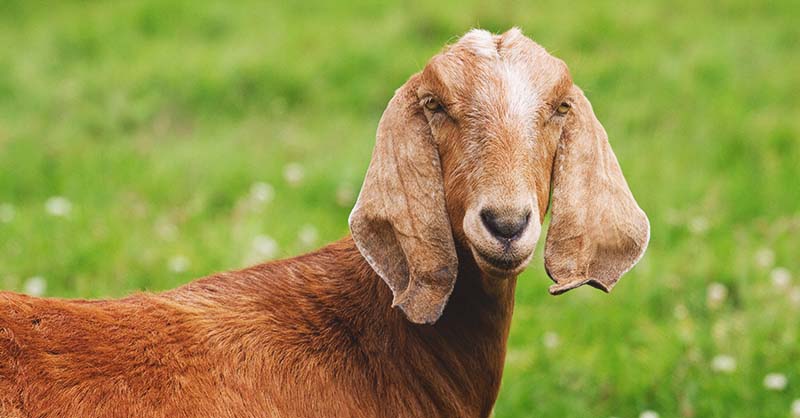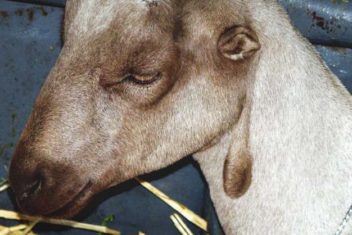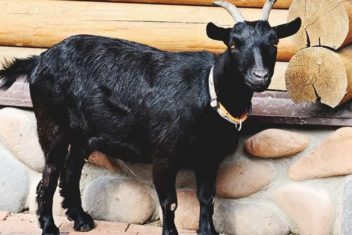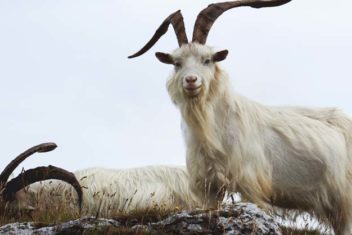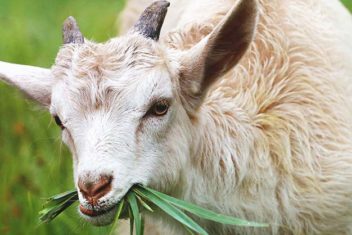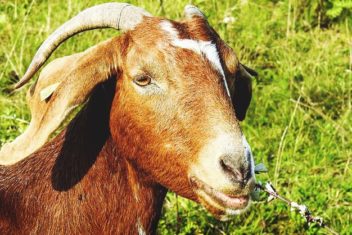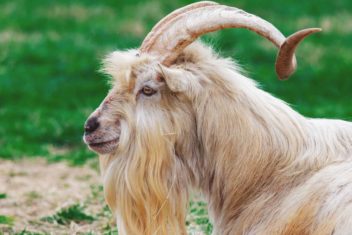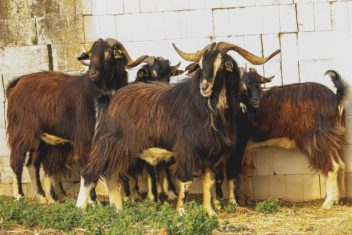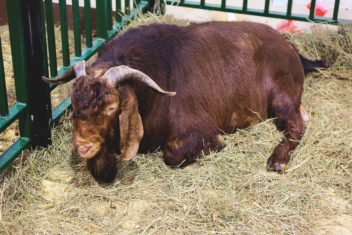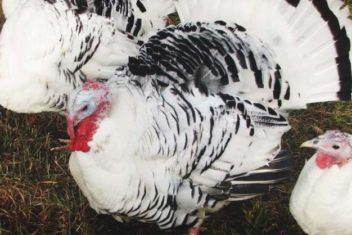Have you ever noticed the regal, flowing ears of the Nubian goat and wondered why they are so popular? Sturdy, noble animals, Nubians are well-known for producing milk with high butterfat content, vocal personalities, and, yes, those long, adorable ears.
The Nubian goat is a beautiful goat with origins as diverse as the many colors they come in. Goats imported from Africa, India, and the Middle East have contributed to creating this dairy goat breed, with England being the cradle where the Nubian dairy goat was refined into the breed it is today.
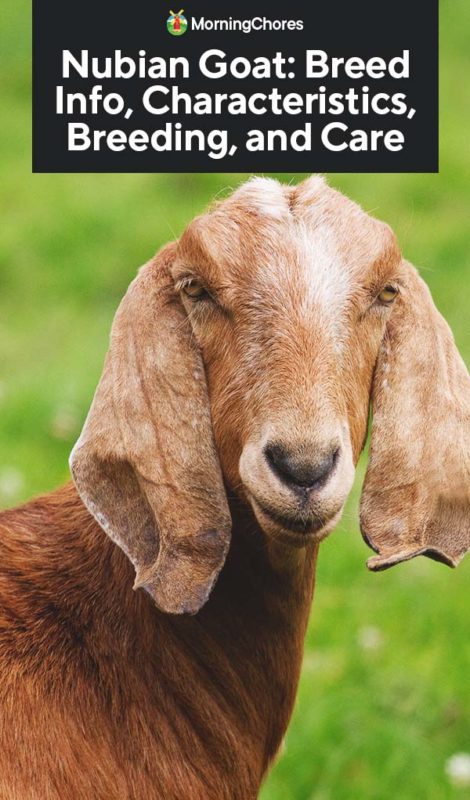
Breed Standards of the Nubian Goat
The American Dairy Goat Association (ADGA) and the American Goat Society (AGS) are the most common registries for dairy goats in the United States.
Registration lets you know your stock is purebred and gives you a database to glean from if strong milking lines are important to you. It’s also required if you want to show your goats.
If registered stock is your preference, here are requirements to keep in mind.
1. Height and Weight
According to AGS, Nubian goats does must weigh no less than 130 lbs. and stand 30” at the withers (the base of the shoulders). Registered bucks need to be at least 160 lbs. and 32” at the withers.
Nubians are one of the largest dairy goats and at one point were used as a dual-purpose goat providing meat as well. Today their milk lines have been emphasized to where they are no longer considered meat goats, but their more fleshy body condition is a throw-back to their dual-purpose days.
2. Color
Both ADGA and AGS accept all Nubian goat colors and patterns.
3. Other Breed Specific Standards
According to ADGA, the “Nubian should be a relatively large, proud, and graceful dairy goat of mixed Asian, African, and European origin, known for high-quality, high butterfat, milk production.”
ADGA goes on to describe desirable qualities in Nubians.
“The head is the distinctive breed characteristic, with the facial profile between the eyes and the muzzle being strongly convex (Roman nose). The ears are long (extending at least one inch [2.54 cm] beyond the muzzle when held flat along the face), wide and pendulous. They lie close to the head at the temple and flare slightly out and well forward at the rounded tip, forming a “bell” shape. The ears are not thick, with the cartilage well defined. The hair is short, fine and glossy.”
Typical Characteristics
Nubian Goats are appreciated for their milk with a high butterfat content, sweet milk flavor, and the fact that their milking season is reported to last longer than most dairy breeds.
1. Dairy Production Details
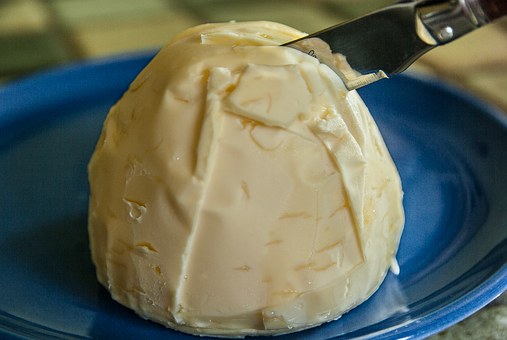
Nubians give between 4%-5% butterfat content. To put this in perspective, this is twice the amount of fat in a gallon of 2% milk from the grocery store.
This signature feature makes Nubians the first choice for homesteaders making their own cheese, ice cream, cottage cheese, and other homemade goodness. Remember all goat milk is naturally homogenized so make sure you invest in a cream separator if you’re wanting to make dairy products.
It is true that on average Nubians don’t give as much milk as their Swiss cousins, averaging about 3/4 to 1 gallon a day. However, a dairy goat of any breed will give as much milk as the parental and maternal lines behind her.
Diet also plays a huge role in milk production. Research a doe’s lines and know what she consistently produces or at least what her mother and both grandmothers produced if she is a kid.
Nubians are known for their sweet milk. To be safe, always ask to taste a potential doe’s milk, as off-tasting milk can be a symptom of mastitis or other health issues.
2. Hardiness
Due to their tropical origins, Nubians are well-adapted to all climates and tend to be on the hardier side of dairy breeds.
3. Temperament
Of all dairy breeds, Nubians are by far the most vocal. We once had neighbors whose Nubian goats would cry at their backdoor watching them go about their home life. It drove our neighbors batty, but some Nubian owners love the more dependent tendencies saying it makes the goats more affectionate and easier to handle.
Nubians are a most popular dairy breed and often times their affectionate nature is listed as one of their merits.
Breeding Nubian Goats
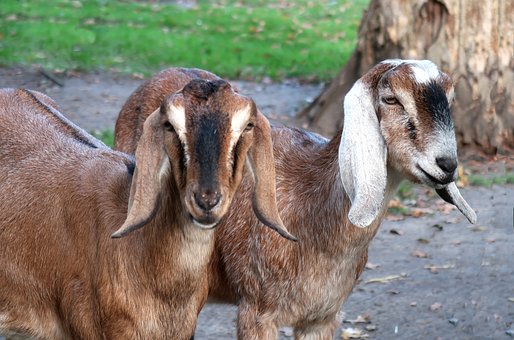
1. Maturity
The rule of thumb for breeding all dairy goats holds true for Nubians with a few minors variations, which I touch on below.
Both doelings and bucklings can breed as early as 7 weeks, though this is not advised. A doe is typically considered mature enough to be bred if she is 8 months old or weighs at least 80 lbs.
Both does and bucks do not reach full size until around their second birthday, with a doe reaching her full milk potential about that same time.
2. Mating Season
True to dairy goat form, Nubian goats are seasonal breeders. This means they can only be bred at certain times of the year, normally between July to December.
Nubians do have an unusual quality in that it is said their breeding season lasts longer. This means it’s possible they can be bred later or even skip a year between breedings.
During the breeding season, a Nubian doe will cycle every 18-21 days with her heat or fertile period lasting a few hours to two days. Like deer, Nubian bucks go into rut with the approach of fall and are quite smelly. Because of this, it is recommended not to run does and bucks together since the buck’s smell can taint the taste of the milk.
3. Kids
The gestation period of a dairy doe lasts about 150 days. Nubian goats are excellent mothers and can have up to five kids, though 2-3 are the norm.
Nubian Goat Care
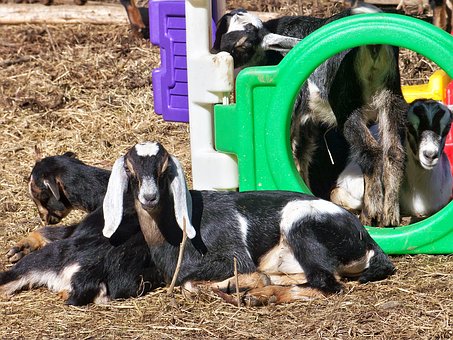
1. Feeding and Nutritional Needs
Being larger animals, Nubians need grain to maintain healthy production. Like all ruminants, they need continuous access to hay, fresh water, and minerals (check to see what minerals may be deficient in your area).
2. Housing and Fencing
While Nubians are not known for being escape artists like Alpines, they are still goats. Sturdy fences like cattle panels or dependable electric wire is a must.
While they can withstand warm and cool temps, Nubians need a goat shed or house to shelter them from wind, rain, snow, and hot days.
3. Grooming
Goats are tidy animals and dairy goats like Nubians do not need shearing as fiber goats do. There are a few basic grooming needs that will make both your and their life easier.
– Hoof trimming
Nubians’ hooves need to be trimmed every 4-6 weeks. To trim hooves you will need goat or sheep hoof trimmers and a hand-held wood shaver to smooth the hooves when you are finished. A milking stand or head shoot is also helpful but not necessary if your goat is trained to stand still.
– Udder Hygiene
Shaving a doe’s udder and underbelly will keep your milk cleaner and make it easier to hand milk. A sturdy pair of dog grooming clippers and blades will do a great job.
– Bathing
Most of the time, goats tend to their own cleaning needs, but there may be times when a bath is in order. Simple water and soap will be enough and is a great way to cool your Nubian friend on a hot summer day.
– Show Grooming
Since Nubians are gorgeous animals you may found yourself interested in bringing them to the show ring. If you dream of showing, there will be required grooming to compliment their features.
4. Health Issues and Care
Parasites are enemy number one for all goats. Nubians will need regular deworming and practices like small herd sizes and rotational grazing will help disrupt parasites’ life cycle.
Nubians long ears do make them more vulnerable to frostbite. Make sure they can get out of winter winds in a warm, draft-free shelter and be prepared to give them a safe heat source if temperatures become extreme.
5. Training
The younger you start, the more trainable your Nubian will be. The following are several training situations your Nubian should be exposed to.
– Milk Stand Training
The best time to train a doe to a milk stand is long before you need to milk. Even doelings can be lead onto the stand and fed on it to give a positive connection. Training a first-time milker takes some time and patience, but a gentle hand and a bucket of feed does wonders.
– Lead Training
Again, the younger you train a Nubian to a lead rope, the easier it will be. Slip the lead loosely around their neck and lead them in short, low-pressure sessions.
– Show Training
The best way to prepare Nubian goats for the show ring is to practice like it is the real deal. In showing, goats have to stand and walk on command. Learn the various postures required in the show and make your Nubian as comfortable performing as possible.
– Pack Training
Because they are larger goats, Nubians – bucks and wethers (castrated males) especially – would be great pack animals. Start with lead training and then slowing accustom the goat to a burden by starting with a strap around the middle and then slowly increase the weight over time.
Alternatives to Nubians
Do you need a smaller goat that still gives high butterfat like Nubians? Nigerian Dwarfs are an excellent alternative to Nubians, with their butterfat being even higher.
Their mini size also makes them more feasible for a small homestead. Besides the fact, they’re just downright cute!
Did You Know?
Outside of the United States, Nubians are called Anglo-Nubians because of their English influence. Yet, it is Nubia – now modern-day Sudan – that gave them the part of their name they are universally recognized by.
In 1896 a breeder from California imported 3 Nubian does and two bucks. Although it would be 1913 before the Nubian dairy goat became an official breed in the United States, most Nubians in America stem back to these five Californian Nubians.
Conclusion
Nubian goats are an excellent choice for homesteads wanting to break their dependence on the grocery store for dairy products. If these dependable, affectionate beauties fit what you are looking for, you’ll find a fun and sturdy animal with the Nubian dairy goat.
